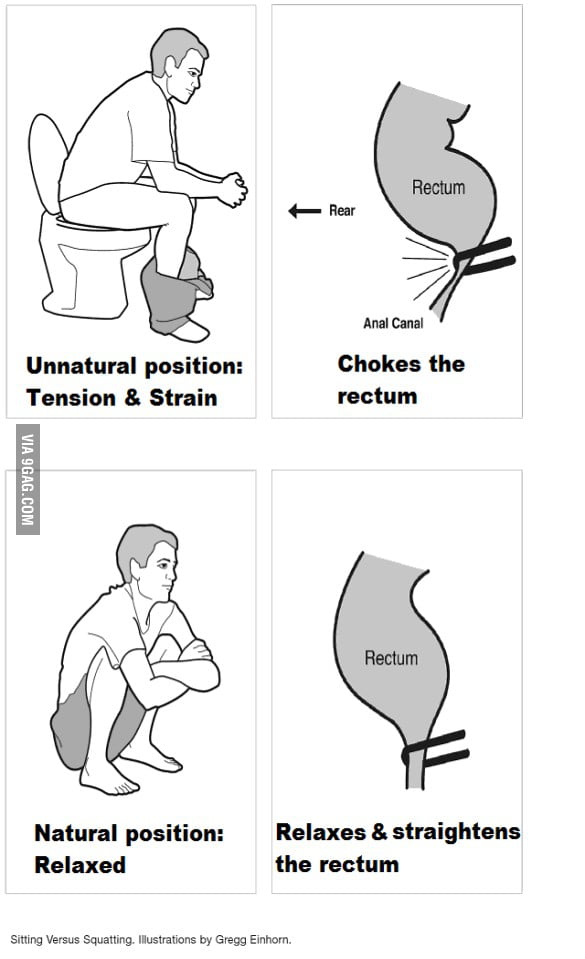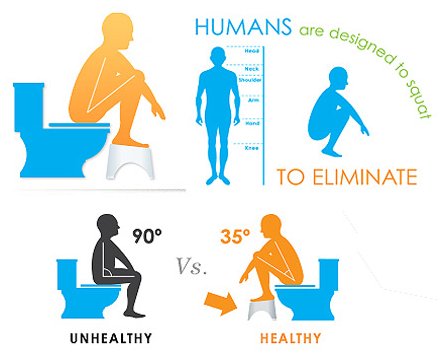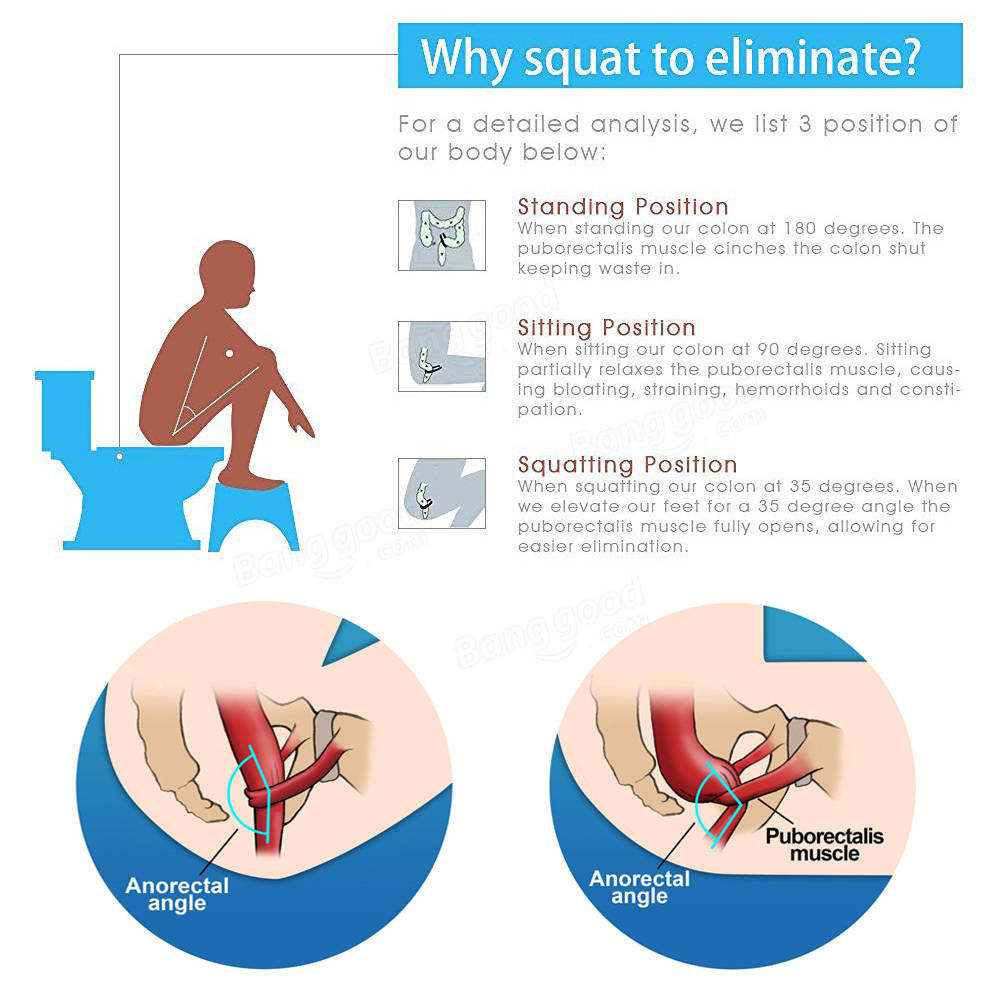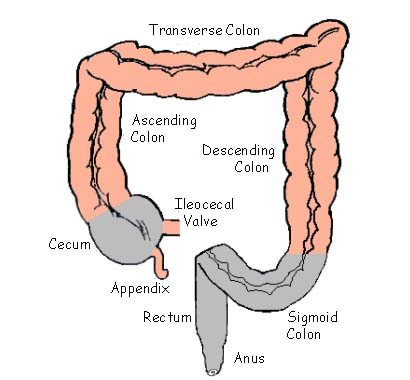

You have been sitting on the toilet bowl, invented by an obese person, the wrong way for your entire life, thus far, if you are still using the sitting toilet bowl . Read on... How do you sit on the toilet bowl?
Probably like this ,( see above pictures_ or sometimes even sitting upright like this? But did you know, that this is in general the most unhealthy pooping position?
Because at this 90 degree angle, the natural path of your intestine is pinched and literally blocked. In the worst case, this can lead to constipation, irritable bowel syndrome, hemorrhoids, or intestinal cancer. When you squat down , at a 35-degree (your back thigh to the calf muscles (gastrocnemius) angle, it is completely different:
This position of squatting is completely normal and learned from a young age. With knees bent at 35-degree angle, here roughage/stool follows its natural path.
Since your modern toilet bowl design isn't likely to change, it is recommended to place your feet on a step-stool while doing/pooping your 'business'.

A simple step suffices. Try it out and you'll be surprised! The relief and ease.

Pooping Posture!

Do you suffer from or have suffered from hemorrhoids, constipation, colon disease, ileocecal valve issues, or urinary tract infections? Research shows that squatting, rather than sitting, during bowel movements makes defecation more efficient and easier with less strain. Thus squatting helps avoid the above mentioned health problems.
Constipation and Hemorrhoids
Constipation and hemorrhoids go hand in hand as hemorrhoids are inflamed anal varicose veins that are the result of excessive pressure applied during hard to pass stools or constipation.
Most of us know that proper hydration and fiber intake are important to avoiding constipation but many of us do not consider the importance of bathroom posture. Anatomically, humans best eliminate stool when squatting.
The puborectalis muscle, which normally squeezes the rectum shut, is relaxed fully when squatting allowing for full and easy elimination. Less pushing and strain is necessary because less colon obstruction is present allowing stool to pass more freely. On the contrary, when sitting, the puborectalis muscle is not fully but only partially relaxed leading to more difficulty in the elimination process.
Colon Disease and ileocecal valve issues

During proper elimination not only should the puborectalis muscle be fully relaxed, but the ileocecal valve should close. Both of these things happen when we squat but not fully when we sit. Fecal buildup in the colon from incomplete elimination, and soiling of the small intestine from incomplete closure of the ileocecal valve, can lead to many health issues including colon disease and ileocecal valve issues to name a few.

The ileocecal valve (ileal papilla, ileocaecal valve, Tulp's valve, Tulpius valve, Bauhin's valve, ileocecal eminence, valve of Varolius or colic valve) is a sphincter muscle valve that separates the small intestine and the large intestine. Its critical function is to limit the reflux of colonic contents into the ileum.Approximately two litres of fluid enters the colon daily through the ileocecal valve.
The ileocecal valve is distinctive because it is the only site in the gastrointestinal tract that is used for Vitamin B12 and bile acid absorption
Urinary Tract Infections for Women
Not only is squatting beneficial when passing stool but also during urination. When squatting, rather than sitting, the bladder is more efficiently emptied as urinary flow is stronger, lowering risk of urinary tract infections.


Bladder Inflammation ↑
Start Squatting!
I first heard about the squatting technique from a friend who suffers from digestive issues. He mentioned to me that he started squatting during bowel movements and saw a reduction in his symptoms from doing this. My friend actually climbs up on to the toilet with his feet on the bowel and squats down. If you do not feel comfortable doing this, they do sell a product called the squatty potty which I stumbled upon when doing my research for this post!
If you do decide to start squatting please let me know how it goes, I am interested in the results!

3 positions of our human body. What happen inside?
1. Standing Position
When standing, our colon is at 180 degrees. The puborectalis muscle cinches (secures) the colon shut keeping waste in.
2. Sitting Position
When sitting, our colon is at 90 degrees. Sitting partially relaxes the puborectalis muscle, causing bloating, straining, hemorrhoids and constipation.
3. Squating Position (100% Relax Position)
When squatting , our colon is at 35 degrees. When we elevate our feet for a 35 degree angle the puborectalis muscle fully opens, allowing for easier elimination. Learn this lesson that a free-falling object, in our case here is stool, is an object that is falling under the sole influence of gravity. A free-falling object has an acceleration of 9.8 m/s/s, downward (on Earth). Plops Sound.
If you have constipation, do Paida aka tapping /slapping on your hand back for ten minutes.
Be Prince or Princess of Poop

Your poop is an indicator how well your body eliminates waste and keeps everything functioning. Here is what it says about your health:


Do You know your Poop Story?



A person's body waste can say a lot about his or her health. How often you go to the bathroom, and how much waste you expel, can indicate your general digestive health.
"The digestive tract contains more bacterial cells than there are cells in the entire body," said Dr. Jean-Pierre Raufman, a gastroenterologist at University of Maryland School of Medicine. "It's very important that our bowels work well to absorb necessary nutrients but also keep out any foods, chemicals and germs that could do us harm."
While most people probably don't want to put much thought into the act of going to the bathroom, it's an essential body function that can tell them if something is wrong. A change in bowel movements could be due merely to a change in diet, but it could also mean the body is fighting an infection or dealing with a serious condition.
Here are five hints that your body waste could be giving you about your health.
Color
Stool color is often a reflection of what you eat. While various shades of brown are considered normal, some colors like black or yellow are not.
"Black stool could indicate bleeding in the stomach or the first part of the small intestine," Raufman said.
Iron supplements can darken the stool to more of a dark green, he added. Taking bismuth-containing medicines, such as Pepto-Bismol, or eating black licorice or blueberries also may cause black stools.

Bright red stool usually suggests that blood is coming from the lower part of the digestive system, such as the large intestine, rectum or anus.
Pale white or yellow stool also can mean a problem.
"The reason why stool is brown is because of our normal production of bile," Raufman said. "If there's a problem with bile flow, that may mean a problem like cancer of the bile ducts, or pancreatic cancer or hepatitis."
Shape
A change in stool shape also could be cause for concern. Stools that are narrow and pencil-thin are thought by some experts to be a symptom of colon cancer.
"It could be a sign of obstruction in the lower part of the colon," which means the bowel is partially blocked, getting in the way of the fecal matter that is passing through, Raufman said.
Another sign of a potential problem is soft stool. Stool that sticks to the side of the toilet bowl, or is difficult to flush, could indicate the presence of too much oil.
"Oil floats, so you'll see it in the water," Raufman said. "They look like fat droplets, which can mean the body isn't absorbing the fats properly." Diseases such as chronic pancreatitis block the body from properly absorbing fat.
Whether stool floats depends on how much gas is in it. "Generally, stool that sinks or floats don't mean there's a problem," he said.
Smell
Though the smell of feces can be rather unpleasant, smells that are particularly strange or foul shouldn't be ignored.
"It's hard to tell people that stool can smell even worse, but it can," Raufman said. "If there is a change in your stool that persists or is unusual, you should see your doctor."
Stool is made up of undigested food, bacteria, mucus and dead cells. It usually smells bad because of the bacteria and parasites, but it also can have compounds that produce an especially unpleasant smell.
"If you have blood in your stool, that usually comes with a particular strange odor," he said. "Also, stool with a lot of fat can smell particularly bad."
Reasons for a foul smell could include certain medications, having food that's been stuck in the colon for too long, or having an infection, he said.
Constipation
Dry, hard stools that are hard to eliminate are a sign of constipation. People who are constipated may have bowel movements fewer than three times a week.
Constipation is a common complaint, and most people experience it at least once in their lives. More than 4 million Americans have frequent constipation, according to the National Institute of Diabetes and Digestive and Kidney Diseases.
Constipation could be caused by a number of factors, including a poor diet, lack of exercise, certain medications, lack of fluids or various bowel disorders.
If ignored, constipation could lead to complications such as hemorrhoids or rectal bleeding. The best way to relieve symptoms is to follow a well-balanced high-fiber diet, drink plenty of water, try to exercise regularly and go to the bathroom when you feel the urge.
Diarrhea

Diarrhea happens when loose, watery stools pass through your bowels too quickly. Generally it lasts one or two days and goes away on its own.
"It's a normal way for the body to get rid of toxic substances, like bacteria or viral infections," but it also can lead to dehydration, Raufman said.
Parasites found in water and food can enter the body and disrupt the digestive system, causing diarrhea that can last several days.
Diarrhea also can suggest a more serious problem. Diarrhea that lasts for at least four weeks may be a sign of a chronic disease, such as irritable bowel syndrome or Crohn's disease.
But diarrhea also could be a sign of chewing gum that contains sugar alcohol, such Xylitol or sorbitol. Raufman said, "Someone who chews one or two packs of sugar-free gum a day could also get diarrhea."

⇧ 80 percent of colon cancers develop in the gray-coloured areas, which cannot be fully evacuated/eliminated by sitting position on the toilet bowl.
Fecal stagnation is the major cause of colon disease.
BROWN POOP: NATURALLY BROWN DUE TO THE BILE PRODUCED IN YOUR LIVER.
YELLOW POOP: INDICATES EXCESS FAT WHICH COULD BE DUE TO A MALABSORPTION DISORDER LIKE CELIAC DISEASE. YOU'RE FINE. POOP IS GREASY FOUL-SMELLING.
YELLOW GREEN POOP: MAY BE YOUR LARGE INTESTINE MOVING THROUGH TOO QUICKLY OR YOU COULD HAVE EATEN LOTS OF GREEN LEAFY VEGGIES OR GREEN FOOD COLOURING FOOD.
BLACK POOP: BLEEDING INTERNALLY DUE TO ULCER OR CANCER. SOME VITAMINS CONTAINING IRON OR BISMUTH SUBSALICYLATE COULD CAUSE BLACK POOP TOO. PAY ATTENTION IF IT'S TICKY AND SEE A DOC IF YOU'RE WORRIED.
LIGHT-COLOURED WHITE OR CLAY-COLOURED POOP: YOU'RE NORMALLY SEEING IT COULD MEAN A BILE DUCT OBSTRUCTION SOME MEDS COULD CAUSE THIS TOO. SEE A DOCTOR.
BLOOD-STAINED OR RED BLOOD IN YOUR POOP COULD BE A SYMPTOM OF CANCER. ALWAYS SEE A DOCTOR RIGHT AWAY IF YOU FIND BLOOD IN YOUR STOOL.
DRINK MORE WATER AND CHOMP ON SOME FRUITS AND VEGGIES .
Ever since the first human being descended on the Earth, squatting has been the most natural posture to finish one's daily “business”.
With the advent of civilizations, human habits (discipline), shelter (housing), clothing (cotton & silk), food (farming & cooking) and several factors evolved but the seating posture for defecation remained the same i.e squatting posture.
The very fact that such a posture comes naturally even to fetus in the womb and children while playing further proves that it is the most commonly used posture by humans.

In Yogasanas, there is a very popular posture called “Shashankasana” which provides a massaging effect for abdominal organs & stimulates the nervous action of the bowels to give a good motion. Even in squatting position, the same effect is observed. If you rotate a photograph of Shashankasana by 90 degrees, you can notice how similar it is to the squatting posture.

Cultural Deviation From Nature
When the flush toilet was invented during 16th century, it caught some eyeballs but was still limited to royalty who adored it’s seating posture which seemed more “dignified” (since it’s posture resembled sitting on a throne). Over the next few centuries, it gradually witnessed penetration into the masses of western world (Europe & America), and by 19th century, it had become the norm for them. However, eastern world (India, China, Japan, Korea) chose not to switch and stuck on to doing their business in squatting posture.

Over the last few decades, bowel related diseases like hemorrhoids, appendicitis, constipation, irritable bowel syndrome have been on the rise especially in the western world due to several reasons including diet & lifestyle. That triggered a series of experiments and research studies in which scientists & doctors began to notice an interesting pattern. They noticed that the probability of such diseases was higher when one used the western toilet. Further research on this topic revealed that the seating position for western toilet was actually against human anatomy.
💩💩💩💨💨💨 poop or pudding or chocolate ice cream with a smiley face Pop Not chocolate ice cream like my mum P It looks like something my brother would eat. To me, this emoji means you're having a happy poop.
Health Benefits. Let Earth Gravity Do The Work, while you squat.
Medical Studies
A recent 2010 Japanese study on the Influence of Body Position on Defecation in Humans, taken together with earlier findings, suggest that the greater the hip flexion achieved by squatting the straighter the recto-anal canal will be, and accordingly, less strain will be required for defecation.
http://onlinelibrary.wiley.com/doi/10.1111/j.1757-5672.2009.00057.x/abstract
A 2003 Israeli study by doctor Dov Sikirov discovered it took ‘squatters’ an average of 51 seconds for a bowel movement while ‘sitters’ took an average of 130 seconds.
http://www.springerlink.com/content/rlu7151837n07562/
Infants instinctively squat
Infants instinctively squat to poo, as does the majority of the world's population. Studies* confirm that the most effective posture for urination and defecation is the squat position. Squatting is as basic to good health as drinking plenty of water, eating a balanced diet, getting enough sleep, and exercising regularly. Given this knowledge, is it worth letting infants squat over a potty longer?
With assistance young children can use the step of the Lillipad to gain access to the lowered toilet seat which they can squat on. The step is also useful for children accessing the hand basin.
“Thank you. It arrived today and have already caught my 4 year old squatting on it! He was very excited and it looked completely natural for him.” ⎯ Sara, NZ
Squatting experience
People who are new to squatting will tell you that they urinate and defecate more effectively, and are gaining flexibility. This personal experience convinces them that squatting is beneficial. For example;
“I was having real problems with my bowels, I have diverticulosis and a prolapsed bowel. I was having bowel movements at least 3 or 4 times a day and passing a small amount of fluid that stained my underwear, also a small amount of fresh blood. Well I purchased a book called Happiness is a Regular Complete Bowel Motion and that is where I got the idea to look on line for the Squat-pad. I have been using the Squat-pad since August (5 months) and now most days I have a complete regular bowel motion, no more stained underwear, it is absolutely amazing. I still prefer to pass urine sitting.” ⎯ Pam, (NZ)
“I had been bleeding with every single BM for six months. The first time I squatted, no blood, and no blood since then. It is amazing. This is how they use the toilet in developing countries, and it is how our bodies are made to defecate. It is so much easier on our bodies to do it this way.” ⎯ Anonymous.
“I am so happy for what you guys are doing. Squatting is the natural way to excrete, and the sit toilet is the reason why there are so many gastrointestinal ailments in this world. I have lived in China where they have very comfortable squat toilets. I know the difference between sitting and squatting. I'm so glad you guys are encouraging the Western world to finally come out of the dark ages and revert back to the more civilized natural way to excrete! Keep up the good work!!!” ⎯ J. Liu, USA
“It’s working out real well. No more bothersome hemorroids!" ⎯ E.S, (California)
“It is my feeling squatting of this kind helps in rehabilitation of knee conditions...at times (it has helped my knees after bilateral arthroscopic surgery).” ⎯ Witold Falkowski, MD. Orthopedic and trauma surgeon (retired) Hemel Hempstead G.H.
“I’ve been using this baby for about a year..I don't get a lot of exercise - but nature calls a few times a day and my legs; ankles and knees especially, are in better shape then they've possibly EVER been! (ok, they were pretty good when I was 12, 63 almost now!!)” ⎯ Mike, (US)
“And most of all, thanks for your product which has saved me from so much pain!” ⎯ Simon, (UK)
“I am now happily squatting and enjoying the already obvious benefits — along with my wife and two kids, who are now former skeptics.” ⎯ Bruce, (Germany)
“Been using the Lillipad for couple weeks now, and all i can say is....EUREKA !!!” ⎯ Carlos, (Australia)
Be proactive in avoiding colon cancer
The effective removal of excrement from the colon is vital, failure to do so can cause constipation which may increase the risk of colon cancer.
Alleviate hemorrhoids
In the squat position the large intestine aligns correctly. The thighs supporting the abdomen prevent hernias and massage the intestine into action. The muscular contractions that push food along the digestive tract are hindered by the sitting position, yet assisted by squatting. The squat position eliminates the need for excessive straining alleviating hemorrhoids.
Optimum birthing position
During birth the squatting position gives a greater increase of pressure in the pelvic cavity with minimal muscular effort. The birth canal will open 20—30% more in a squat than in any other position. Squatting will prevent haemorrhoids which often plague pregnant women. Squatting each day on the Squat-pad will help prepare the body for this excellent birthing position.
Beneficial spinal stretch
Squatting is a difficult position to adopt straight away, be patient and give yourself a couple of weeks to get used to squatting. The muscles we use to defecate are exercised by getting down into, and up out of, the squat position. Not only will your balance improve, you will also give your spine a beneficial stretch.
Promote squatting
You can squat on the rim of a toilet, but be careful and check for cracks and sturdiness first. The squatting platform offered in the plans and the Squat-pad are safer options, they also promote the healthy concept of squatting to others. You can promote squatting by informing your friends on social media or linking to this blogsite. http://theinnozablog.blogspot.sg
Squat toilets are also known as Arabic, Chinese, French, hole in the ground, Indian, Iranian, Japanese, Korean, natural-position, Nile pan, squatty potty, Kimchi squat, Turkish, and hunkerin’ toilets!
Squat on the loo its good for you!
Empty both bowel and bladder using the natural squatting position.
*References
1. 2010 Japanese study on the Influence of Body Position on Defecation in Humans.
http://onlinelibrary.wiley.com/doi/10.1111/j.1757-5672.2009.00057.x/abstract
2. Dr. Dov Sikirov, Digestive Diseases and Sciences, Vol. 48, No.7 (July 2003)
http://www.springerlink.com/content/rlu7151837n07562/
3. Sikirov, B.A. Israel Journal of Medical Sciences, 1987: 23
4. Alexander Kira. The Bathroom. New York: Penguin, 1976
5. Janet Balaskas. New Active Birth. London: Thorsons, 1991
6. Joseph Heller and William Henkin. Body Wise. New York: J.P. Tarcher Inc./St Martin's Press, 1986
7. Journal of Obstetrics and Gynaecology of the British Commonwealth, 1969
8. Jacobs, E.J. and White, E. Epidemiology, 1998 July, 9 (4)

No comments:
Post a Comment